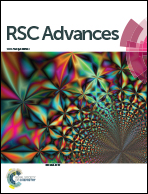Signal on fluorescence biosensor for MMP-2 based on FRET between semiconducting polymer dots and a metal organic framework
Abstract
A signal on fluorescence biosensor for ultrasensitive detection of MMP-2 based on fluorescence resonance energy transfer (FRET) between semiconducting polymer dots (Pdots) and a metal–organic framework (MOF) has been developed. Carboxyl-rich PFO has been modified firmly with a polypeptide chain (COOH–GHHYYGPLGVRGC–NH2) through a carboxy ammonia reaction first. The polypeptide chain comprises the specific MMP-2 substrate domain (PLGVR) and the π-rich motif (HHYY) can be absorbed by the MOF (H2dtoaCu used in this study) through π-staking interactions. Hence, the fluorescence from Pdots can be quenched by the MOF with the assistance of the polypeptide chain linker through the FRET process. Upon the cleavage of the substrate by the protease (MMP-2) at the amide bond between Gly and Val, the Pdots has been separated from the MOF surface and therefore the FRET process can be inhibited, and the fluorescence of the system recovered. Under optimal conditions, the fluorescence recovery was found to be proportional to the concentration of MMP-2 within the range of 0.1 to 2.5 pg mL−1.


 Please wait while we load your content...
Please wait while we load your content...